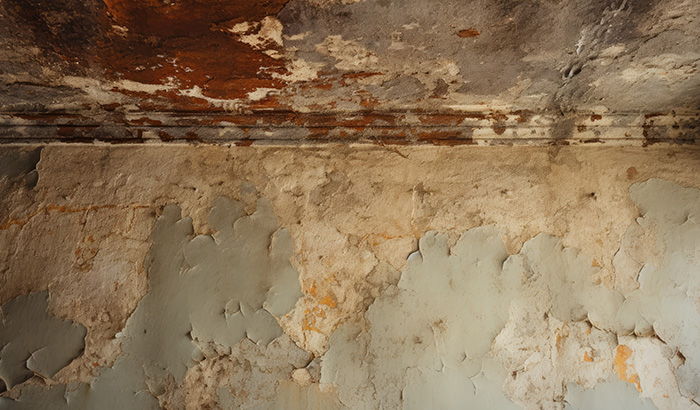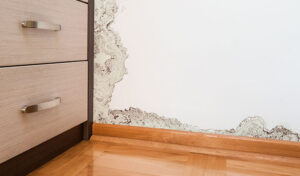Mold is a silent invader that can wreak havoc on your property and health. Often lurking in hidden corners or manifesting in plain sight, its presence is more than just an aesthetic issue — it’s a serious concern that demands immediate attention. But how do you know if mold has made its way into your home or office? And more importantly, what should you do if you find it?
Spotting the signs and learning how to get rid of mold is essential to keeping the environment around you clean and safe for everyone. Keep reading to learn what mold is, why it’s problematic, what signs of mold to look for, and how to get rid of mold once you’ve found it.
What Is Mold, and Why Is It a Concern?
Mold is a fungus that consists of tiny organisms found almost everywhere — in the air, on surfaces, and even in some foods. Mold spores are microscopic and can easily float through the air, landing on various surfaces. When these spores land on a moist surface, they can begin to grow, forming visible colonies.
Mold thrives in damp, humid, and warm conditions, often growing in places like bathrooms, kitchens, basements, and attics.
Mold plays an essential role in nature by breaking down dead organic matter, such as fallen leaves and dead trees. However, when mold grows indoors, it can become a problem. It can cause health issues, structural damage, and financial problems.
5 Signs of Mold to Look For
1. Visual Signs:
When it comes to mold detection, visual inspection remains one of the most reliable methods for early identification. Recognizing the visible signs of mold is crucial for timely intervention, as mold compromises the structural integrity of your property and poses significant health risks. Here are some key visual indicators to look for:
a. Color Variations: Mold manifests in a variety of colors, including but not limited to black, green, white, and orange. Black mold, often referred to as Stachybotrys chartarum, is particularly notorious for its potential health risks, although it’s important to note that not all black molds are toxic. Green molds like Aspergillus and Cladosporium are also commonly found in homes.
b. Texture and Pattern: Mold colonies often exhibit a fuzzy or slimy texture. They may appear as irregular patches or spots on surfaces. In some instances, mold growth can also take on a powdery appearance. The growth pattern can be either dispersed or concentrated, depending on the extent of moisture and the type of material on which it is growing.
c. Location: Mold commonly thrives in areas with high humidity and poor ventilation. Therefore, visual inspections should focus on bathrooms, kitchens, and basements.
In the bathroom, check for mold around tiles, on walls, and in the corners of showers and bathtubs. Inspect areas under the sink, around the refrigerator, and near other water sources in kitchens. In basements, check walls near pipes and windows.
2. Odor:
The olfactory cues associated with mold are often the first indicators alerting individuals to its presence, even before visual signs become apparent.
The scent is usually described as “musty,” “earthy,” or “damp,” akin to the smell of wet socks or rotting wood. This distinct odor is unpleasant and a critical warning sign of potential health risks and structural issues. Here’s how the odor can clue you into the presence and location of mold:
a. Chemical Composition Behind the Odor: The musty odor is primarily due to microbial volatile organic compounds (MVOCs) produced by mold as it grows and metabolizes its food source. These MVOCs are gaseous byproducts that easily disperse into the air, making them readily detectable by the human nose.
b. Odor as an Early Warning System: The musty odor can often be detected before mold becomes visible. This is particularly true for mold growing in hidden areas, such as behind walls, carpets, or crawl spaces. The scent is an early warning system, allowing for prompt investigation and remediation before the mold spreads or causes significant damage.
c.Pinpointing the Location: The intensity of the odor often correlates with the proximity to the mold source. A stronger smell usually indicates that you are closer to the area where mold is growing. This can be particularly useful for pinpointing hard-to-reach or hidden locations. By following the scent, you can often locate the mold source more quickly, saving time and resources in the long run.
3. Water Damage:
Water damage is often a precursor to mold growth and is a critical indicator that immediate attention is required. Mold requires moisture to grow; water-damaged areas provide the ideal conditions for mold spores to germinate and proliferate.
The different types of water damage that can indicate mold include water stains, peeling or bubbling paint and wallpaper, warping or buckling, and efflorescence, which is a white, powdery substance on walls that can indicate water seepage and potential mold growth behind the surface.
4. Health Symptoms:
Mold exposure can lead to a range of health symptoms that vary in severity depending on individual sensitivities, the type of mold, and the duration of exposure.
While these symptoms are not exclusive to mold exposure and can indicate other medical conditions, their sudden onset or exacerbation in specific environments may serve as a clue to the presence of mold.
Here are some health symptoms that can alert you to the potential existence of mold in your surroundings:
a. Respiratory Symptoms include coughing, wheezing, and shortness of breath.
b. Allergic Reactions include sneezing, runny or stuffy nose, itchy or watery eyes, and skin rash.
c. Neurological Symptoms include headaches, fatigue, and difficulty concentrating.
d. More Severe Symptoms include asthma attacks, sinus infections, and immune system reactions.
Pay attention to when and where you notice your symptoms. If symptoms improve when you’re away from a particular environment and worsen upon return, this pattern could indicate mold in that location.
5. High Humidity Levels:
Humidity plays a pivotal role in the mold lifecycle, serving as an essential element that facilitates its growth. High humidity levels in an indoor environment can indicate the potential presence of mold and create the ideal conditions for its proliferation.
When the relative humidity in an indoor space exceeds 60%, it creates an environment conducive to mold growth. Mold spores absorb moisture from the air, enabling them to germinate and form colonies.
To prevent humidity levels from getting too high, you can measure humidity levels with a hygrometer. Keeping levels below 60% is advisable but can be difficult in bathrooms, kitchens, basements, and laundry rooms.
Keeping an eye out for signs of mold, like visible condensation, a musty odor, and health symptoms, can help you identify it immediately.
How to Confirm Mold Presence
Suspecting the presence of mold based on visual signs, odors, or health symptoms is one thing, but confirming its existence requires a more rigorous approach.
Accurate identification is crucial for effective remediation and to ensure that the health risks and structural damages associated with mold are adequately addressed. Here are some reliable methods to confirm the presence of mold:
- Visual Inspection: While a visual inspection can provide preliminary evidence, it is not definitive proof of mold presence. Some molds are not easily visible or may be growing in hidden areas. Therefore, visual inspection should be the first step, not the sole identification method.
- Professional Mold Testing: This involves air, surface, and bulk sampling, along with culture tests. Bulk sampling is where you examine materials like wallboard or carpet for mold spores. Culture tests are sample cultured in a lab to identify the type of mold and its concentration.
- DIY Mold Testing Kits: These testing kits are helpful to an extent, but they are less sensitive than professional tests, might not be as accurate, and don’t provide information on the spore count or concentration.
- Moisture Meters: Devices like moisture meters can measure moisture levels in materials like wood and drywall. High moisture levels in these materials can indicate the likelihood of mold growth, although they do not confirm mold presence.
- Infrared Cameras: Some professionals use infrared cameras to detect temperature differences in walls and other surfaces, which can indicate moisture problems and potential mold growth.
How to Get Rid of Mold
Discovering mold in your property can be alarming, given its potential health risks and structural implications. However, it’s crucial to approach the situation calmly and methodically to ensure effective remediation.
First, you’ll isolate and ventilate the area and put on personal protective equipment to ensure your safety and prevent the mold from spreading. Then, you’ll inspect the area visually to see if you can find the mold. We recommend using a flashlight for this step.
Once you’ve found the mold, you’ll want to test it to determine what kind it is and quantify the spore count. Then, you can either try to remove it yourself or call the professionals.
Once the mold is repaired, you’ll want to address the underlying cause, whether that be a leak, an issue with ventilation, or excess moisture.
Total Flood and Fire Restoration Are Experts at Mold Remediation
Don’t want to tackle mold remediation on your own? We don’t blame you. It’s not a fun process and presents its hazards to DIYers. So, at the first signs of mold, call Total Flood and Fire Restoration.
At Total Flood and Fire Restoration, we specialize in comprehensive mold assessment and remediation services that are both effective and reliable. Call us at 385.503.2846 to schedule an appointment today. Together, we’ll combat the mold and get you back to living in a safe, healthy environment.








